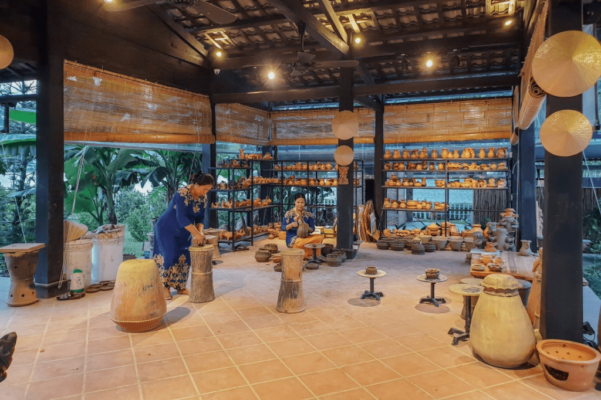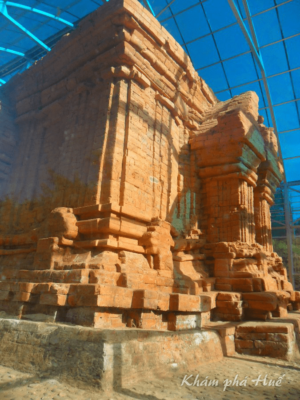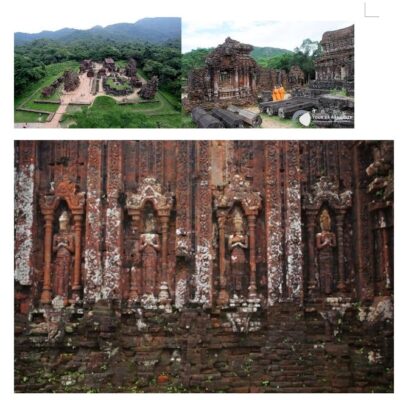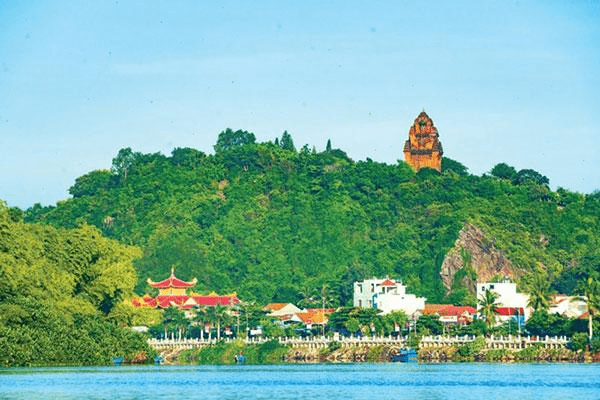No products in the cart.
News, Useful information
TRAVELING TIPS: DISCOVER THE PA CULTURE CULTURE OF CENTRAL VIETNAM
Along the strip of Vietnam today in ancient times existed three countries. In general, the north is Dai Viet territory, the central area is the area of the cultural kingdom of Champa and the south is part of the territory of Phu Nam kingdom.

Source of Cham culture corner
The Champa culture was developed from the Sa Huynh culture. Currently, the coastal provinces along the Central region from Quang Binh – Binh Thuan and the Central Highlands provinces belonged to the ancient Champa cultural territory. Over thousands of years, some towers have been broken, there are ancient mosses caused by natural disasters and human destruction, now most have been restored to preserve an ancient culture, preserving the traditional values, typical beauty from architecture, craft villages to festivals bearing national identity. More specifically, this is also the place to stop by tourists coming to Vietnam as well as the central coastal provinces of the Central Highlands
Huge and unique Cham towers are one of the important factors that contribute to creating the characteristic of Cham culture. This is a brick-built structure of red, pink, dark red, extending and tapering in the shape of a flower, the proportions of the parts of the tower having a human being, meaning it is derived from humans. Most of the tower plan is square with a narrow interior space, often with open doors to the East (towards sunrise), the rest sides are fake doors, often placed on open positions, hills, far away. where people live. The top of the tower is reduced gradually or leveled up, in the heart of the tower is a stone altar. The special thing of Cham tower is the delicate and impressive carvings.
Thanks to the creativity adapting to the harsh weather of the mountainous and coastal areas of the people of Central Vietnam, Cham Pa people have shown the cultural exchange and development process of the ethnic minorities. Hard. The famous Cham towers in Vietnam are My Son holy land, Poklong Garai tower, Ponagar tower, Banh It tower …
Traditional turmeric village in Cham Pa culture
Champa culture is also famous for traditional craft villages. In the past, the Cham people did many handicrafts for their living, such as making pottery, weaving fabrics, building buffalo cars, boats, and making jewelry … Nowadays, most of them have lost their lives, only pottery and brocade are still spreading. develope. Bau Truc pottery village and My Nghiep weaving village are two craft villages on the list of conservation and development and also a cultural tourist destination of Cham Pa people. Currently, Bau Truc is a cultural tourist destination for Cham ethnic groups in Ninh Thuan province, and has been invested quite a lot.

Cham Pa clay village
Clay is the most important ingredient in creating masterpieces, skillfully molded. Is a type of clay taken on the banks of the Quao River. Ceramic products are sculpted in the most rustic way, with distinctive patterns but also very close to daily life such as flowers, rivers, shells …
Festivals in Cham Pa culture
Besides traditional craft villages, Champa culture is also famous for famous festivals such as rain pray festival, Katie festival, Ramuwan festival, Roya Phik Trok festival, Po Nagar tower festival, opening ceremony Cham tower door … in which the most important festival and impress diners is Kate festival. The festival commemorates the deceased, commemorates the national heroes (honored by the Cham as a god). Usually held on July 1 according to the Cham calendar (September 25 to October 25 of the solar calendar). The people gathered at the ancient temples and towers to enjoy the folk dances of the Cham period. Rituals of ceremony to welcome the procession of clothing, opening ceremony of the tower door, the ceremony of bathing the idol, the ceremony of dressing for the idol, the ceremony. When the sacred dance ends, outside the Cham tower begins to celebrate.
Katie festival
The Katê festival is held on a small scale, taking place in each village, one day after it is a festival one by one family. Members of each family gather together, there is a presiding person. Usually selected as head of household, elderly, or head of the clan. They wish their families peace, children and grandchildren in the family prosper, and have many luck. This is an opportunity for all members of the family to be close and unite, an opportunity for fun and entertainment after a year of hard work.
If you want to explore more clearly, witness with your own eyes the grandeur of the architecture as well as better understand, check-in for yourself the “delicious” pictures with hidden beauty, ancient beauty, cultural features. representations of Champa culture, please visit the series of places I mentioned below!
Map of Cham temples and towers in Vietnam

Map of Cham temples and towers in Vietnam
1. Quang Binh, Quang Tri, Thua Thien Hue
The provinces of Quang Binh, Quang Tri, and Thua Thien Hue were located to the north of Hai Van pass, the northernmost region of the ancient Champa kingdom. In this area there is still a small tower, discovered in 2001 in My Khanh village, Phu Dien commune, Phu Vang district, Thua Thien Hue province.
Although there are not many temples and towers still standing on the ground, but still found in the northern region of Champa many vinegar foundations, sculptural artifacts and some epitaphs. The epitaphs from the 6th to the 10th century mention the construction of the temples and towers of Siva as well as Buddhist works. The artistic style of the sculpture shows the unity of the area with its southern neighborhoods.

My Khanh Tower is a unique historical and cultural relic recently found by archaeologists in 2001 (because it was previously covered by sand), now in My Khanh village (Phu Dien commune, Phu Vang district, Thua Thien Hue province). The tower was built in the early 13th century and belongs to one of the oldest Cham towers in Vietnam. This tower has the style of My Son E1 ancient architecture. This is the land of Champa and became Dai Viet in the event that King Champa Che Man offered Chau O and Chau Ri to the wedding ceremony to propose Princess Huyen Tran.
Champa culture in Quang Nam

Referring to the Champa culture in Quang Nam, people immediately think of My Son Sanctuary. My Son Sanctuary is located in Duy Tan commune, Duy Xuyen district, 70km southwest of Da Nang. According to the statistics of the French researcher H.Parmentier, there are more than 70 monuments and temples in My Son in My Son. This used to be the place of worshiping of the Champa dynasty as well as the tomb of the Champa kings or princes and national favorites.
Forgotten for a long time up to centuries, it was not until 1885 that it was discovered and My Son Sanctuary was recognized by UNESCO as a world heritage site in 1999. The sanctuary has just brought its mark of history. old, classic, distinctive architecture, often with festivals with graceful, unique Cham dance … everything makes up a distinct feature of My Son when visitors visit.
This place is a complex of many temples of the Champa kingdom, located in a small valley about 2 km in diameter, surrounded by mountains and hills. Architectural styles here are divided into 6 categories: ancient, Hoa Lai, Dong Duong, My Son, PoNagar and the styles of the people of Binh Dinh. Most of the architectural works, sculptures here are influenced by Hinduism.
In addition to My Son Holy Land, visitors can also visit temples which are equally massive as the group of Chien Dan towers (Tam An, Tam Ky, Quang Nam, 60km south of Danang). , Bang An (Bang An village, Dien An, Dien Ban, Quang Nam, 30km south of Da Nang), Khuong My tower (Tam Xuan commune, Nui Thanh district, Quang Nam).
Binh Dinh Champa culture

Binh Dinh is the second largest cultural and political center of Champa. Binh Dinh is the hiding place for a mighty Champa era, with many top notch elements of Champa architecture and sculpture. Banh It Tower is an impressive spot that tourists cannot ignore.
Silver Tower (Banh It Tower) is located in Nhon Hoa commune, An Nhon district, 18km north of Quy Nhon. This tower cluster was built in the 11th century on a high hill, so it looks very majestic from a distance, still admired from the highway. This work is the pride of the Binh Dinh people, where there are very unique and rich architectural features, still bold the art and culture of ancient Champa but still has very unique features of the martial land. . The appearance of elements such as cladding columns with longitudinal grooves, sandstone roof fringes, soaring arches … on the tower are the features that can be considered as the typical temples of Binh Dinh style. In terms of artistic means, in all the remaining Cham Towers in Vietnam, Banh It Tower is a unique group of Banh Less, an architectural relic of high artistic value.
In addition, there are also Hung Thanh Twin Towers (Quy Nhon City, Billion) which is classified as a “unique” beauty category of Champa architectural art. The tower was built at the end of the 12th century and early 13th century. The tower has a square body, the top of the tower is curved, the corners of the tower show the statue of Garuda with two hands raised as if to support the roof. The corners of the tower are shaped like Garuda, which is the factor that influenced Khmer art in the 12-13 century. The tower was ranked by the Ministry of Culture and Information as an Art Architecture relic in 1980.
In addition, there are towers like Binh Lam tower (Phuoc Hoa commune, Trung Phuoc district), Canh Tien tower (Nhon Hau village, An Nhon district), Thoc Doc tower (Nhon Thanh commune, An Nhon district), Thu Thien tower ( In Thu Thien commune, Tay Son district), Thap Duong Long (Nga Thap), this tower cluster is located in Binh An commune, Tay Son district, 40km northwest of Quy Nhon.
Cham Pa Monuments Phu Yen

Located in the heart of Tuy Hoa city (Phu Yen province), Thap Nhan National monument has become a unique feature of both architecture, art and belief. Nhan Tower has become one of the beautiful symbols when it comes to Tuy Hoa city, a new tourist attraction of Phu Yen. Most tourists like to visit Nhan Tower because it can see the whole Tuy Hoa city including sea, river, copper, mountain …
NHan tower

Nhan Tower is located on Nhan mountain, north bank of Da Rang river, Tuy Hoa town, Phu Yen province. It is one of the great architectural works of the Cham people built around the 12th century. The architecture of the Nhan Tower consists of three parts according to the conception of the Cham people, they are: mundane, spiritual and divine. Nhan Tower is one of the large entrance towers 20m high, 11m wide body, with many historical values.
Nhan Tower is not only a special architectural work of art but also has historical and national value. During the war, shells caused the top of the tower and the three corners of the tower to fall. After that, it was restored relatively complete as today. The Ministry of Culture and Information (now the Ministry of Culture, Sports and Tourism) recognized the tower as a national architectural – artistic relic in November 1988.
Cham Pa ruins in Khanh Hoa

Located on a small hill about 2 km north of Nha Trang city center, next to National Highway 1, is the famous PoNagar tower. The tower was built in the eleventh century to worship the mother of the country Po Inu Nưgar.
Ponagar tower

Ponagar tower is the largest Cham architectural complex in Vietnam today. All consists of 3 parts: the Gate Tower area, the Mandapa (for pilgrims to rest, prepare offerings and prepare their clothes before the official ceremony on the tower) and finally the temple tower area. But now there are only 5 works left by the destruction of nature.
Cham culture in Ninh Thuan

As a province where many Cham people live, Ninh Thuan has bold culture of the ancient Cham people. Everything is shown through writing, national costumes, sculpture, architecture, pottery, brocade weaving.
Hoa Lai Tower (Ba Thap) is located close to Highway 1, in Tan Hai commune, 14km from Phan Rang city. The tower was built in the eighth century so it looks ancient and desolate.
With special outstanding value, the architectural and archaeological relic of Hoa Lai Tower (Thuan Bac district, Ninh Thuan province) is ranked by the Prime Minister as a Special National Monument (in Decision No. 2499 / QD-TTg dated December 22, 2016).
In addition to Hoa Lai, there is Po Klong Garai tower (Phan Rang city – Thap Cham, Ninh Thuan, 7 km west of Phan Rang city). Po Klong Garai is an architectural complex built in the reign of King Jaya Simhavarman 3, late 13-14 century. However, at present, there are only 3 brick towers: the gate tower is 9.35m high, the Fire tower is 20.5m high, the main tower is worshiping King Po klong Karai. This is one of the most beautiful towers of the Cham people. This place usually takes place the monumental Katê festival of the Cham people in Ninh Thuan annually.
Ppo Rome Tower (west of Thon palei (Hau Sanh), Ninh Phuoc district) also features typical features of the remaining Cham culture in Ninh Thuan, built in the seventeenth century, is the last stage of turmeric. architectural techniques of Cham towers. The tower is located on a lovely hill, about 14km southwest of Phan Rang city. Po Rome Tower was ranked a national architectural-art monument in August 1992.
Tourism of Cham Pa relics in Binh Thuan

Phu Hai Tower (in Cham Bajaj language) is the remaining Cham tower in Binh Thuan. The tower is 7km from the center of Phan Thiet city, to the northeast to worship Ppo Xah Inu (Cham people often call Po Xah Inu tower) .This tower was built very early, in the eighth century, in the style of Khmer architecture (8 ).
These are prominent towers bearing a bold characteristic of the Champa culture, I would like to introduce to everyone. People can have an overview through Da Nang Museum of Cham Sculpture when they do not have time to go to each province. The museum covers architecture, festivals, costumes, simulated architectural works and also the remaining monuments on display here.
BY hanamihotel

Phu Hai Tower (in Cham Bajaj language) is the remaining Cham tower in Binh Thuan. The tower is 7km from the center of Phan Thiet city, to the northeast to worship Ppo Xah Inu (Cham people often call Po Xah Inu tower) .This tower was built very early, in the eighth century, in the style of Khmer architecture (8 ).
These are prominent towers bearing a bold characteristic of the Champa culture, I would like to introduce to everyone. People can have an overview through Da Nang Museum of Cham Sculpture when they do not have time to go to each province. The museum covers architecture, festivals, costumes, simulated architectural works and also the remaining monuments on display here.
BY hanamihotel
